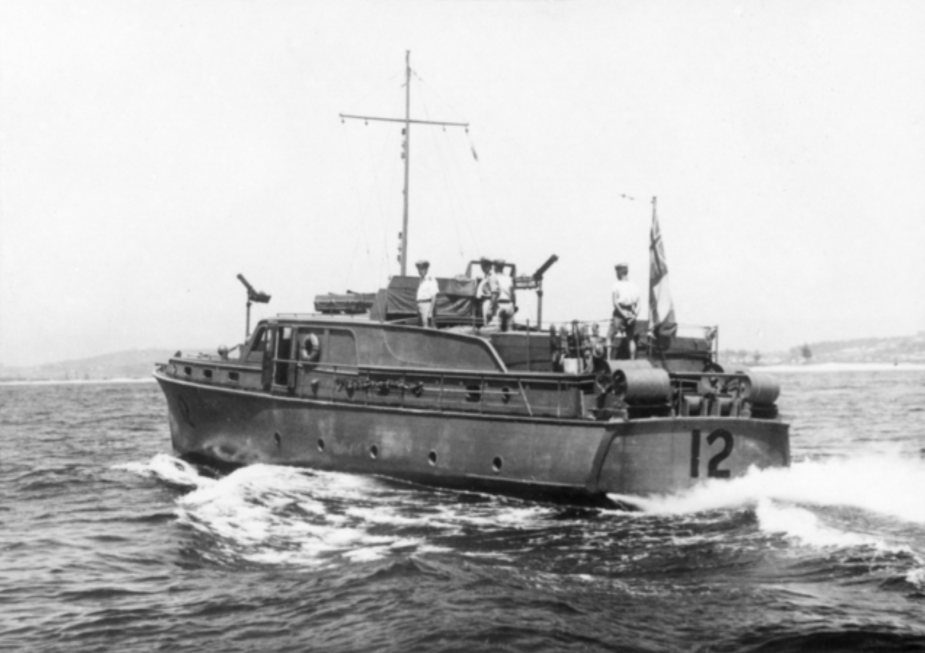
Steady Hour featured prominently during the Japanese miniature submarine attack on Sydney Harbour on the night of 31 May 1942.
The following year, just before midday on 13 April 1943 while conducting a boom net patrol, Steady Hour reported sighting a disturbance in the water in the eastern channel and initiated a depth charge attack supported by Marlean. The Port of Sydney was consequently closed to outward shipping, and shipping bound for Sydney from Newcastle and Port Kembla was also suspended. Three distinct oil patches were observed in the water but there was no further evidence of enemy submarine activity, even after divers had entered the water to investigate.
On 18 April 1944, having transferred to the Naval Auxiliary Patrol, Steady Hour departed Sydney with Sea Mist, both under tow by HMS Springdale, bound for Darwin and service as Air-Sea Rescue (ASR) vessels. They arrived in Darwin, via Cairns, Thursday Island and Melville Bay, on 22 May 1944. While in Cairns in late April and early May work was carried out in both vessels to improve ventilation in their respective engine rooms to address what the Naval Officer in Charge, Cairns, Captain Ernest Rhodes ADC RAN, considered to be a hazardous environment due to heat and fumes; an assessment which was later disputed by the Deputy Engineer Manager at Garden Island, Commander Otto McMahon OBE RAN.
Upon arrival in Darwin Steady Hour was initially assigned to ASR duties in the Wessel Islands group in the East Arnhem region, and later to West Bay on the Coburg Peninsula. In early October, it investigated a report of a submarine in the vicinity of Lesueur Island off the Kimberley coast of Western Australia.
Steady Hour reverted to the Channel Patrol Boat group in November 1944 at which time its Commanding Officer, Skipper John Sykes, commissioned as a Sub Lieutenant in the RAN Volunteer Reserve. The boat returned to Darwin in early January 1945 to have its engines replaced. It was slipped later in the month, and it was subsequently decided that the engine change out should be conducted in Townsville due to the scope of the work. It departed Darwin on 26 February in company with Sea Mist and MV Alma Doepel.
On 3 March, Steady Hour and Sea Mist stopped at Melville Bay in East Arnhem in order to repair a cracked bearing in Sea Mist’s port engine. While refuelling alongside the RAAF jetty a static electric spark ignited fumes in Steady Hour’s starboard fuel tank causing a large explosion and fire. The crews of both Steady Hour and Sea Mist courageously fought the flames but the fire quickly took hold igniting the vessel’s ammunition. It was subsequently evacuated and towed clear by an RAAF work boat. After an unsuccessful attempt to sink its it was beached south of Drimmie Head. Several members of Steady Hour’s crew suffered burns including its Commanding Officer, Sub Lieutenant Sykes. Sykes was to make a full recovery, later commanding HMAS Mischief before being promoted Lieutenant in July 1945. He demobilised on 5 March 1946.
The subsequent Board of Inquiry found a static spark ignited fumes that had accumulated in a void above the fuel tank. The Board determined that the crews of both vessels did everything possible to extinguish the fire and salvage the ship. The Board also specifically recorded ‘their appreciation of the action of Telegraphist Percy Allan Shirley, O/N B4611 of HMAS ‘SEA MIST’ in diving into shark infested waters to rescue Leading Seaman [William] Piper who was blown overboard from ‘STEADY HOUR’ and is unable to swim.’ Telegraphist Allan Shirley was later further commended by the Naval Board for his actions.